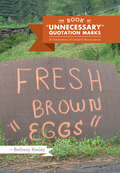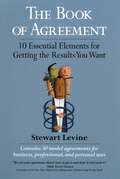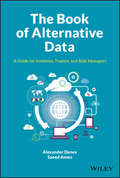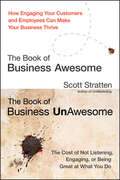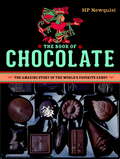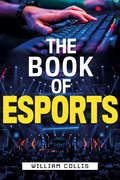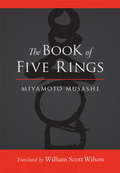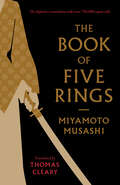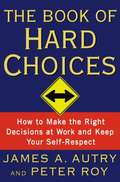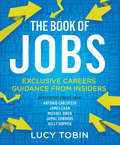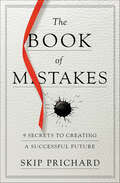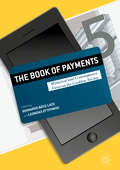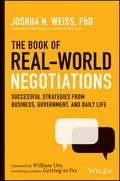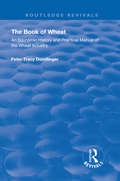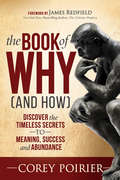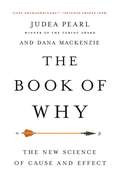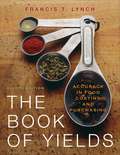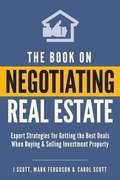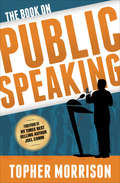- Table View
- List View
The Book of "Unnecessary" Quotation Marks: A Celebration of Creative Punctuation
by Bethany KeeleyFrom the popular blog, a hilarious and horrifying survey of quotation mark abuse in all its forms.From the sarcastic to the suggestive, here are quotation marks as we love them best, doing horrible damage to the English language. Who wouldn’t have second thoughts about ordering the “hamburger” on the diner’s menu? Would it be best to skip the “blowout” sale at the department store? What hidden price must be paid for something marked “free”? Assembled by the creator of the wildly popular “Blog” of “Unnecessary” Quotation Marks, this book surveys the havoc wreaked by quotation marks on signs, menus, placards, and posters that leave reality upended by supposed “facts.” This smarty-pants guide is “perfect” for desperate grammarians, habitual air quoters, and anyone who appreciates a good laugh.
The Book of Agreement: 10 Essential Elements for Getting the Results You Want
by Stewart LevineCrafting agreements with others is a fundamental life skill. Unfortunately, we were never taught how to do it. The agreements most people make are incomplete and ineffective-they usually focus on protecting against what might go wrong instead of figuring out how to make things go right. The Book of Agreement offers a new approach. Stewart Levine demonstrates the superiority of "agreements for results" versus "agreements for protection" and outlines ten principles for creating agreements that explicitly articulate desired outcomes and provide a roadmap to achieving them. He includes over thirty specific templates that can be used to create this new type of agreement for results in a variety of organizational and personal contexts.
The Book of Alternative Data: A Guide for Investors, Traders and Risk Managers
by Saeed Amen Alexander DenevThe first and only book to systematically address methodologies and processes of leveraging non-traditional information sources in the context of investing and risk management Harnessing non-traditional data sources to generate alpha, analyze markets, and forecast risk is a subject of intense interest for financial professionals. A growing number of regularly-held conferences on alternative data are being established, complemented by an upsurge in new papers on the subject. Alternative data is starting to be steadily incorporated by conventional institutional investors and risk managers throughout the financial world. Methodologies to analyze and extract value from alternative data, guidance on how to source data and integrate data flows within existing systems is currently not treated in literature. Filling this significant gap in knowledge, The Book of Alternative Data is the first and only book to offer a coherent, systematic treatment of the subject. This groundbreaking volume provides readers with a roadmap for navigating the complexities of an array of alternative data sources, and delivers the appropriate techniques to analyze them. The authors—leading experts in financial modeling, machine learning, and quantitative research and analytics—employ a step-by-step approach to guide readers through the dense jungle of generated data. A first-of-its kind treatment of alternative data types, sources, and methodologies, this innovative book: Provides an integrated modeling approach to extract value from multiple types of datasets Treats the processes needed to make alternative data signals operational Helps investors and risk managers rethink how they engage with alternative datasets Features practical use case studies in many different financial markets and real-world techniques Describes how to avoid potential pitfalls and missteps in starting the alternative data journey Explains how to integrate information from different datasets to maximize informational value The Book of Alternative Data is an indispensable resource for anyone wishing to analyze or monetize different non-traditional datasets, including Chief Investment Officers, Chief Risk Officers, risk professionals, investment professionals, traders, economists, and machine learning developers and users.
The Book of Business Awesome / The Book of Business UnAwesome
by Scott Stratten Alison KramerUnAwesome is UnAcceptable. The Book of Business Awesome is designed as two short books put together—one read from the front and the other read from the back when flipped over. Covering key business concepts related to marketing, branding, human resources, public relations, social media, and customer service, The Book of Business Awesome includes case studies of successful businesses that gained exposure through being awesome and effective. This book provides actionable tools enabling readers to apply the concepts immediately to their own businesses. The flip side of the book, The Book of Business UnAwesome, shares the train-wreck stories of unsuccessful businesses and showcases what not to do. Key concepts include the power of peripheral referrals and how to create content for your "third circle" Explains how to re-recruiting your employees and re-court your customers Ensure that your business remains awesome, instead of unawesome, and apply these awesomely effective strategies to your business today.
The Book of Chocolate: The Amazing Story of the World's Favorite Candy
by Hp NewquistChocolate . . . - Its scientific name means “food of the gods.”- The Aztecs mixed it with blood and gave it to sacrificial victims to drink.- The entire town of Hershey, Pennsylvania was built by Milton Hershey to support his chocolate factory. Its streetlights are shaped like chocolate Kisses.- The first men to climb to the top of Mount Everest buried a chocolate bar there as an offering to the gods of the mountain.- Every twenty-four hours, the U.S. chocolate industry goes through eight million pounds of sugar.- Its special flavor is created by a combination of 600 to 1000 different chemical compounds Join science author HP Newquist as he explores chocolate’s fascinating history. Along the way you’ll meet colorful characters like the feathered-serpent god Quetzalcoatl, who gave chocolate trees to the Aztecs; Henri Nestlé, who invented milk chocolate while trying to save the lives of babies who couldn’t nurse; and the quarrelsome Mars family, who split into two warring factions, one selling Milky Way, Snickers, and 3 Musketeers bars, the other Mars Bars and M&M’s. From its origin as the sacred, bitter drink of South American rulers to the familiar candy bars sold by today’s multimillion dollar businesses, people everywhere have fallen in love with chocolate, the world’s favorite flavor.
The Book of Crypto: The Complete Guide to Understanding Bitcoin, Cryptocurrencies and Digital Assets
by Henri ArslanianThis book provides a thorough overview of Bitcoin, cryptocurrencies, and digital assets and their impact on the future of money and finance. It provides a 360-degree practical, concise, and engaging overview of all the topics that one interested about digital assets needs to know including how Bitcoin and Ethereum work, an overview of the most important digital assets in the market, and deep dives into the various types of digital assets including cryptocurrencies, stable coins, CBDCs, utility tokens, security tokens, NFTs, and many others. The book also covers all the essentials including DeFi, crypto mining, crypto regulations, crypto investors, crypto exchanges, and other ecosystem players as well as some of the latest global crypto trends from Web 3.0 and the Metaverse to DAOs and quantum computing. Written by a leading industry expert and thought leader who advises some of the leading organisations in the digital assets space globally, this book is ideal for anyone looking to acquire a solid foundational knowledge base of this fast-growing field and understand its potential impact on the future of money.
The Book of Esports
by William CollisThe definitive guide to the modern world of competitive gaming and the official history of Esports™. Almost overnight, esports—or competitive video games—have exploded into the largest entertainment and sporting phenomenon in human history. The Book of Esports answers: What exactly are esports, and how did they become so popular so quickly?Why did blockbuster video games like League of Legends, Fortnite and Starcraft succeed?Where exactly is all this video gaming headed? What do gamers and college students need to know to position themselves for success in the industry?How do you create a billion-dollar esports business? What strategic choices drive success in the modern gaming industry?Can video games really get your kid into college? (All expenses paid, of course...) Whether you are a lifelong gamer, a curious Fortnite parent, or a businessperson seeking to understand the marketing opportunities of this multibillion-dollar phenomenon, The Book of Esports charts the rise of this exciting new industry, for the first time ever crafting a comprehensive overview of esports and its implications for human competition—and even the future of humanity itself. Gaming luminary and Harvard MBA William Collis has painstakingly translated esports&’ mysteries into a detailed and accessible testament for today. Featuring select interviews from the biggest names in the industry, The Book of Esportsweaves tales of trust, betrayal, and superhuman reflexes into predictive frameworks, explaining exactly why our industry looks the way it does, and how all this growth—and more—is inevitable as the divide between man and machine blurs into oblivion.
The Book of Five Rings
by Miyamoto Musashi William Scott Wilson Shiro TsujimuraAlong with Sun Tzu's The Art of War, The Book of Five Rings is considered to be one of the most insightful texts on the subtle arts of confrontation and victory to emerge from Asia. Composed in 1643 by the famed duelist and undefeated samurai Miyamoto Musashi, The Book of Five Rings analyzes the process of struggle and mastery over conflict that underlies every level of human interaction. For Musashi, the way of the martial arts was a mastery of the mind rather than simply technical prowess--and it is this path to mastery that is the core teaching in The Book of Five Rings. This brilliant manifesto is written not only for martial artists but for anyone who wants to apply the timeless principles of this text to their life.
The Book of Five Rings: A Classic Text on the Japanese Way of the Sword (Shambhala Library)
by Miyamoto MusashiThe Book of Five Rings is one of the most insightful texts on the subtle arts of confrontation and victory to emerge from Asian culture. Written not only for martial artists but for anyone who wants to apply the timeless principles of this text to their life, the book analyzes the process of struggle and mastery over conflict that underlies every level of human interaction. The Book of Five Rings was composed in 1643 by the famed duelist and undefeated samurai Miyamoto Musashi. Thomas Cleary's translation is immediately accessible, with an introduction that presents the spiritual background of the warrior tradition. Along with Musashi's text, Cleary translates here another important Japanese classic on leadership and strategy, The Book of Family Traditions on the Art of War by Yagyu Munenori, which highlights the ethical and spiritual insights of Taoism and Zen as they apply to the way of the warrior.
The Book of Hard Choices
by James A. Autry Peter Roy“There are a thousand acts of duplicity and dishonesty every day, some large and some small, some of which undoubtedly take place in your workplace. The question for all of us is, ‘Are we going to resist or just play along the path of least resistance?’ The first hard choice a person of integrity must make is to choose to live, both personally and professionally, in a way that embodies integrity. The power of this book comes from the real-life, in-the-workplace experiences that these executives have been so generously willing to share. None had easy choices, but that’s the point: Integrity is not about easy choices, it’s about the courage to make the right choices. ” —FromThe Book of Hard Choices All of us like to think that, in any given situation, we’d act with integrity and do the right thing. But what happens when we get to work each morning? Do the same rules we follow in our personal lives apply to our work lives? The lines between right and wrong become blurred when we must weigh our obligations to our employer against our own ideas about what is right and wrong. Should altruism trump profit, even to the detriment of the organization? When should you step in to protect an employee and when should the employee be left to take the heat? If the CEO is up to some unethical accounting, should you always risk your job—and the company’s reputation—to sound the alarm? These are the hard choices, the dilemmas that put your integrity to the test and require you to look beyond organizational policy and industry precedents to find an answer that reflects your personal sense of justice. The Book of Hard Choicesgoes to the heart of these difficult decisions. James Autry and Peter Roy, experienced executives themselves, interviewed numerous leaders about the tough decisions they’ve made on the job. They spoke with people like former Starbucks president Howard Behar, Iowa Cubs owner Michael Gartner, and Governor Tom Vilsack of Iowa as well as entrepreneurs, military officials, members of the clergy, and a whole host of leaders. The authors dig into the thinking process these people went through, as well as the emotional strain, the self-doubt, and the fear of a wrong decision’s impact on their business, family, or coworkers. Not everyone in this book made the right choice, but all of them were forced to examine their values and make decisions in complicated circumstances. The result is hard-won wisdom on how to navigate the ethical gray-areas of work life—from daily challenges to possible career ending choices—and make the best possible decisions in the most difficult situations.
The Book of Jobs: Exclusive careers guidance from insiders
by Lucy TobinThis book is a careers bible fit for today's job market, with exclusive advice and guidance from some of the biggest names in British business. No matter what stage of life one is at, whether a school leaver, university graduate or job changer, finding the right career to suit one's skills and characteristics has never been more challenging. The amount of choice and information can be daunting. Most of us only have a vague idea of what careers really entail on a day-to-day basis and yet that information could steer one towards - or away - from a job or university course. In this book Lucy Tobin has compiled an inspirational guide to the most popular jobs and careers in the UK, giving the inside scoop on what these jobs are really like day-to-day, what skills recruiters are really looking for and what courses to study to get your foot in the door. Jobs covered include: banker, actuary, publisher, fashion designer, barrister, zookeeper, chef, TV presenter, actor, journalist, civil servant, app developer, architect, engineer and psychologist. Lucy's journalistic approach, together with exclusive interviews with chef Antonio Carluccio, designer Kelly Hoppen, Dragon Den's James Caan, astronaut Tim Peake, footballer Michael Owen, author Tracy Chevalier and entrepreneur Jamal Edwards makes The Book of Jobs the careers guide to trust at every stage of life.
The Book of Jobs: Exclusive careers guidance from insiders
by Lucy TobinThis book is a careers bible fit for today's job market, with exclusive advice and guidance from some of the biggest names in British business. No matter what stage of life one is at, whether a school leaver, university graduate or job changer, finding the right career to suit one's skills and characteristics has never been more challenging. The amount of choice and information can be daunting. Most of us only have a vague idea of what careers really entail on a day-to-day basis and yet that information could steer one towards - or away - from a job or university course. In this book Lucy Tobin has compiled an inspirational guide to the most popular jobs and careers in the UK, giving the inside scoop on what these jobs are really like day-to-day, what skills recruiters are really looking for and what courses to study to get your foot in the door. Jobs covered include: banker, actuary, publisher, fashion designer, barrister, zookeeper, chef, TV presenter, actor, journalist, civil servant, app developer, architect, engineer and psychologist. Lucy's journalistic approach, together with exclusive interviews with chef Antonio Carluccio, designer Kelly Hoppen, Dragon Den's James Caan, astronaut Tim Peake, footballer Michael Owen, author Tracy Chevalier and entrepreneur Jamal Edwards makes The Book of Jobs the careers guide to trust at every stage of life.
The Book of Leadership: How to Get Yourself, Your Team and Your Organisation Further Than You Ever Thought Possible
by Anthony GellHave you ever wondered what characteristics are shared by successful business leaders? Have you ever asked yourself what it is that they do differently which makes them and their organisations stand out from the crowd? And what can you learn from them to ensure your own success? If so, The Book of Leadership is for you.Over the last six years, Anthony Gell has conducted interviews with some of the most successful CEOs, entrepreneurs and business thinkers in the world, including Sir Terry Leahy, former CEO of Tesco, Richard Reed, founder of innocent drinks, Olaf Swantee, CEO of EE and Daniel Goleman, author of the bestselling Emotional Intelligence.Now for the first time, he is bringing together hours of exclusive interview footage into a single resource for anybody looking to improve their leadership skills.In The Book of Leadership he combines his own experiences as a CEO with those of the leaders he has interviewed to provide insights and advice in three core areas: * Part 1 looks at leaders as individuals and reveals the personal habits and attributes that have laid the foundations for their success. * Part 2 focuses on what it takes to build and motivate a world class team * Part 3 goes beyond team leadership to identify how the habits of effective leadership are carried through on a larger scale in organisations.
The Book of Leadership: How to Get Yourself, Your Team and Your Organisation Further Than You Ever Thought Possible
by Anthony Gell'Full of seriously good leadership wisdom - a must read for those who aspire to greatness' Richard Koch, bestselling author of The 80/20 Principle 'One of the most stimulating books to read on leadership' Philip Kotler, Professor of International Marketing at the Kellogg School of Management 'Loaded with practical, thought-provoking ideas on leadership that can profoundly affect your life' Brian Tracy, bestselling author of How the Best Leaders Lead and Eat That Frog! Have you ever wondered what characteristics are shared by successful business leaders? Have you ever asked yourself what it is that they do differently which makes them and their organisations stand out from the crowd? And what can you learn from them to ensure your own success? If so, The Book of Leadership is for you.Over the last six years, Anthony Gell has conducted interviews with some of the most successful CEOs, entrepreneurs and business thinkers in the world, including Sir Terry Leahy, former CEO of Tesco, Richard Reed, founder of innocent drinks, Olaf Swantee, CEO of EE and Daniel Goleman, author of the bestselling Emotional Intelligence.Now for the first time, he is bringing together hours of exclusive interview footage into a single resource for anybody looking to improve their leadership skills.In The Book of Leadership he combines his own experiences as a CEO with those of the leaders he has interviewed to provide insights and advice in three core areas: * Part 1 looks at leaders as individuals and reveals the personal habits and attributes that have laid the foundations for their success. * Part 2 focuses on what it takes to build and motivate a world class team * Part 3 goes beyond team leadership to identify how the habits of effective leadership are carried through on a larger scale in organisations.
The Book of Mistakes: 9 Secrets to Creating a Successful Future
by Skip PrichardHave you ever wondered why some people seem to catch all the breaks and win over and over again? What do the super successful know? What is standing between you and your wildest dreams?The Book of Mistakes will take you on an inspiring journey, following an ancient manuscript with powerful lessons that will transform your life. You'll meet David, a young man who with each passing day is more disheartened and stressed. Despite a decent job, apartment, and friends, he just feels hollow . . . until one day he meets a mysterious young woman and everything starts to change.In this self-help tale wrapped in fiction, you'll learn the nine mistakes that prevent many from achieving their goals. You'll learn how to overcome these hurdles and reinvent your life.This success parable is packed with wisdom that will help you discover and follow your personal purpose, push beyond your perceived capabilities, and achieve more than you ever dreamed possible. You'll find yourself returning again and again to a deceptively simple story that teaches actionable insights and enduring truths.
The Book of Payments
by Bernardo Batiz-Lazo Leonidas EfthymiouThis book examines the nature of retail financial transaction infrastructures. Contributions assume a long-term outlook in their exploration of the key financial processes and systems that support a global transition to a cashless economy. The volume offers both modern and historic accounts that demonstrate the constantly changing role of payment instruments. It brings together different theoretical approaches to the study, re-examining and forecasting changes in retail payment systems. Chapters explore a global transition to a cashless society and contemplate future alternatives to cash, cheques and plastic, featuring the perspectives of academics from different disciplines in conversation and industry participants from six continents. Readers are invited to discover the innovation in payment systems and how it co-evolves with changes in society and organisations through personal, corporate and governmental processes.
The Book of Payments: Historical and Contemporary Views on the Cashless Society
by Bernardo Batiz-Lazo and Leonidas EfthymiouThis book examines the nature of retail financial transaction infrastructures. Contributions assume a long-term outlook in their exploration of the key financial processes and systems that support a global transition to a cashless economy. The volume offers both modern and historic accounts that demonstrate the constantly changing role of payment instruments. It brings together different theoretical approaches to the study, re-examining and forecasting changes in retail payment systems. Chapters explore a global transition to a cashless society and contemplate future alternatives to cash, cheques and plastic, featuring the perspectives of academics from different disciplines in conversation and industry participants from six continents. Readers are invited to discover the innovation in payment systems and how it co-evolves with changes in society and organisations through personal, corporate and governmental processes.
The Book of Real-World Negotiations: Successful Strategies From Business, Government, and Daily Life
by Joshua N. WeissReal world negotiation examples and strategies from one of the most highly respected authorities in the field This unique book can help you change your approach to negotiation by learning key strategies and techniques from actual cases. Through hard to find real world examples you will learn exactly how to effectively and productively negotiate. The Book of Real World Negotiations: Successful Strategies from Business, Government and Daily Life shines a light on real world negotiation examples and cases, rather than discussing hypothetical scenarios. It reveals what is possible through preparation, persistence, creativity, and taking a strategic approach to your negotiations. Many of us enter negotiations with skepticism and without understanding how to truly negotiate well. Because we lack knowledge and confidence, we may abandon the negotiating process prematurely or agree to deals that leave value on the table. The Book of Real World Negotiations will change that once and for all by immersing you in these real world scenarios. As a result, you&’ll be better able to grasp the true power of negotiation to deal with some of the most difficult problems you face or to put together the best deals possible. This book also shares critical insights and lessons for instructors and students of negotiation, especially since negotiation is now being taught in virtually all law schools, many business schools, and in the field of conflict resolution. Whether you&’re a student, instructor, or anyone who wants to negotiate successfully, you&’ll be able to carefully examine real world negotiation situations that will show you how to achieve your objectives in the most challenging of circumstances. The cases are organized by realms—domestic business cases, international business cases, governmental cases and cases that occur in daily life. From these cases you will learn more about: Exactly how to achieve Win-Win outcomes The critical role of underlying interests The kind of thinking that goes into generating creative options How to consider your and the other negotiator&’s Best Alternative to a Negotiated Agreement (BATNA) Negotiating successfully in the face of power Achieving success when negotiating cross-culturally Once you come to understand through these cases that negotiation is the art of the possible, you&’ll stop saying "a solution is impossible." With the knowledge and self-assurance you gain from this book, you&’ll roll up your sleeves and keep negotiating until you reach a mutually satisfactory outcome!
The Book of Road-Tested Activities
by Elaine BiechTraining legend Elaine Biech oversees this edited collection of classic activities and games created by stalwarts of the learning community and used successfully for years by professional, front-line trainers. Spanning all types of activities--icebreakers, role-playing, simulations, and energizers--the book covers classic games and activities with new hooks and variations to encourage audience engagement and participation.
The Book of Wheat: An Economic History and Practical Manual of the Wheat Industry (Routledge Revivals)
by Peter Tracy DondlingerFirst published in 1910, this volume was the result of fifteen years of study in the American Northwest. The author contributed to the burgeoning field of industrial and economic history, providing a practical manual for the entirety of the wheat industry at the time. Whilst smaller studies had been published before, this was the first general work on the subject, covering topics including the wheat plant, cultivation, diseases, marketing and production. It was of particular interest to growers, dealers and millers and was accessible to popular readers, students, instructors and experimenters.
The Book of Why (and How): Discover the Timeless Secrets to Meaning, Success and Abundance
by Corey PoirierThe Book of WHY (and HOW) is designed to help people discover their passion, purpose, and mission while also leveraging the top habits of the world’s top achievers. Broken down into three sections, The Book of WHY (and HOW) reveals the four WHYs that can dramatically change a person’s life, the shortest path to thriving in a challenging world, and the key to becoming more enlightened in the process. In short, multiple-time TEDx speaker, Corey Poirier, helps readers tap into their purpose so they can thrive in a more enlightened way. The Book of WHY (and HOW) is unique in the way it addresses the importance of uncovering the WHY while also revealing the HOW. Many people struggle with feeling a lack of purpose in their life and work. They also struggle with how to uncover their purpose as well as what to do with it once they do. The Book of WHY (and HOW) tackles this exact challenge while revealing the timeless secrets Corey Poirier has discovered while interviewing more than 5,000 of the world’s top achievers.
The Book of Why: The New Science of Cause and Effect
by Judea Pearl Dana MackenzieA Turing Prize-winning computer scientist and statistician shows how understanding causality has revolutionized science and will revolutionize artificial intelligence"Correlation is not causation." This mantra, chanted by scientists for more than a century, has led to a virtual prohibition on causal talk. Today, that taboo is dead. The causal revolution, instigated by Judea Pearl and his colleagues, has cut through a century of confusion and established causality--the study of cause and effect--on a firm scientific basis. His work explains how we can know easy things, like whether it was rain or a sprinkler that made a sidewalk wet; and how to answer hard questions, like whether a drug cured an illness. Pearl's work enables us to know not just whether one thing causes another: it lets us explore the world that is and the worlds that could have been. It shows us the essence of human thought and key to artificial intelligence. Anyone who wants to understand either needs The Book of Why.
The Book of Yields: Accuracy in Food Costing and Purchasing
by Francis T. LynchThe only product with yield information for more than 1,000 raw food ingredients, The Book of Yields, Eighth Edition is the chef's best resource for planning, costing, and preparing food more quickly and accurately. Now revised and updated in a new edition, this reference features expanded coverage while continuing the unmatched compilation of measurements, including weight-to-volume equivalents, trim yields, and cooking yields. With helpful worksheets; a clear organisation by food type; and a convenient, durable comb binding, The Book of Yields, Eighth Edition is a must-have culinary resource.
The Book on Negotiating Real Estate: Expert Strategies for Getting the Best Deals When Buying & Selling Investment Property,
by Mark Ferguson J Scott Carol ScottThe principles behind successful negotiation, The psychology of building relationships to gain negotiating leverage, How to uncover and use information to tip negotiating outcomes in your favor, Strategies for defining optimal offers and counter-offers, Tactics for in-the-trenches negotiating and overcoming objections, Strategies for using concessions to get your deal to the finish line, Tips for overcoming tactics employed by those on the other side, How to overcome the challenges of making/receiving offers through agents, Tactics to renegotiate issues that arise from contract contingencies, Strategies to get the best of it when buying properties from banks and HUD.
The Book on Public Speaking
by Topher Morrison&“One of the most powerful professional speakers in America . . . reveals how he&’s earned millions onstage, on camera and in business&” (Steve Siebold, CSP, past chairman of The National Speakers Association&’s Million Dollar Speakers Group). If you look at the trends of over thirty years ago in fashion, technology, architecture, and any other industry, what was cutting edge back then has become cliché and grossly out of date now. But in the speaking industry, most people get up and still walk, talk, and sound like the 1980s motivational speakers of yesteryear. The Book on Public Speaking takes a head-on approach and challenges the status quo for business leaders that speak in front of their staff, board of directors, and the public. After reading this book you will be privy to the most current methods for speaking to an audience for maximum impact in today&’s more sophisticated and skeptical culture. If you are the type of business leader who has achieved a level of success in life and feel compelled to share your story with the world, don&’t lessen that impact by imitating outdated speaking techniques. Instead, break the mold of the speaker cliché and tap into a speaking style that is authentic, packs a punch, and leaves the audience wanting more. &“I learned some amazing presentation techniques from Topher. I&’m using them right now. They&’re awesome. You can&’t tell because you&’re reading this.&” —John Heffron, winner of The Last Comic Standing &“Morrison is crazy good at training you how to communicate on-camera so that your business gets more attention.&” —James Lavers, professional speaker, founder, &“Selling from the Screen&”
